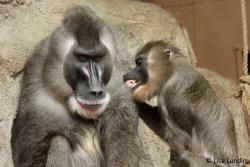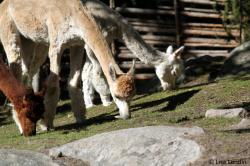Conclusions
Drills

Visitor intensity affects the behavior of drills.
- Inactive and affiliative behaviors in drills decreased when visitor intensity was high compared to low visitor intensity.
- The opposite was found for agonistic, stereotypic/abnormal behaviors and visitor interactions which increased when visitor intensity was high compared to low.
These results are in concordance with previous research and are indicators of drills finding visitors stressful at least to some degree, which can impact the welfare of the drills. Measures to decrease the effects of visitors should be implemented by Parken Zoo to ensure good animal welfare, such as adding visual barriers and increasing the distance between visitors and the enclosure.
Petting zoo animals

Visitor intensity affects the alpacas, goats and sheep in Lilla Zoo as well.
- Desirable behaviors were not seen at high intensity levels and only sufficient amount of times for statistical testing at medium intensity levels in goats.
- In alpacas and goats undesirable behaviors were least frequent when intensity levels were low.
Goats and sheep seem to be well adapted to the petting zoo setting. Alpacas appear to be the most affected by visitors; they only perform desirable behaviors when visitors attempt to feed the animals, perform the most undesirable behaviors and spend the most time in retreat spaces. If they are to be kept free roaming in Lilla Zoo further habituation to visitors is needed.
Keeping visitor intensity level low is also important to facilitate positive interactions between visitors and animals, which is the purpose of Lilla Zoo.
Responsible for this page:
Director of undergraduate studies Biology
Last updated:
05/08/13
